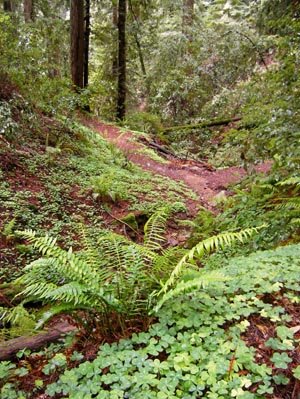One of Mount Madonna’s best features is that it is handy. From
anywhere in south Santa Clara County, you can shoot up to the park,
take a short hike and be back home for lunch.
It’s not the Continental Divide, but Mount Madonna County Park, situated at the crest of the Santa Cruz Mountains, splits the flow of water that it collects from the storm clouds that pass by.
On the west side, water runs directly down to Watsonville and into Monterey Bay, while on the other side, storm runoff takes the long route – through Gilroy to the Pajaro River which breaches the coastal mountains near San Juan Bautista – to the same destination.
One of Mount Madonna’s best features is that it is handy. From anywhere in south Santa Clara County, you can shoot up to the park, take a short hike and be back home for lunch. Earlier this week, a friend and I took advantage of this easy access. On our rolling 2-mile loop, we explored each side of the divide to where the just-born creeks begin separate journeys to Monterey Bay.
A right turn at the top of Hecker Pass (Highway 152 from Gilroy to Watsonville) takes you onto Pole Line Road and the entrance to the park. We paid our day-use fee (currently $6) then followed the road for nearly another mile and parked near the amphitheater.
I pride myself on being a competent navigator even in difficult circumstances, but I must confess being confused as I attempted to match trail junction signs with the layout on the trail map (I have ruled out the decline of old age as a causal factor). We made one wrong turn at a junction that wasn’t even marked. While you may also scratch your head a time or two, you will find the route.
We began our walk on the Upper Miller Trail which begins just to the right of the amphitheater. After a couple hundred yards, we crossed the road and turned left at the intersection with the Blue Springs Trail on the other side.
The show picked up when we reached the Bayview Trail and started our descent into Banks Canyon. The mountain crease that carries this creek down to Watsonville narrows to a lovely hollow of second growth redwoods that have sprouted from the trunks of their harvested predecessors. The clover-like leaves of redwood sorrel look like an emerald carpet that hovers a few inches above the forest floor. Banks Creek gave a youthful gurgle as we crossed it and traversed the slope on the other side. In one sunlit spot, we found a good-sized group of oak violets adding a yellow splash in the shadowy green-brown forest.
The Bayview Trail will eventually reveal views of the Monterey Bay and take you all the way to Highway 152, but we turned left at the Sprig Trail and crossed the road (and the divide) over to the Rock Springs Trail. Once again, we dropped into a rainforest-like wonderland. Massive first growth redwood stumps were cloaked in soft green moss and anchored a ring of second growth trees of impressive proportions. I have walked this trail a number of times, and I love it for the curious spacious quality one feels inside this fully enclosed canopy.
We descended to timid little Blackhawk Creek which carved this groove and followed its course upstream through lush green undergrowth. Sword ferns grew everywhere in clumps, and more redwood sorrel, some with pale pink blossoms, spread across the forest floor. This water will also end up in Monterey Bay, but not before visiting Gilroy and making a long loop down south.
Mount Madonna County Park – handy, yet exotic. Where else can you go to a rainforest and be back by lunch?













